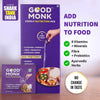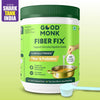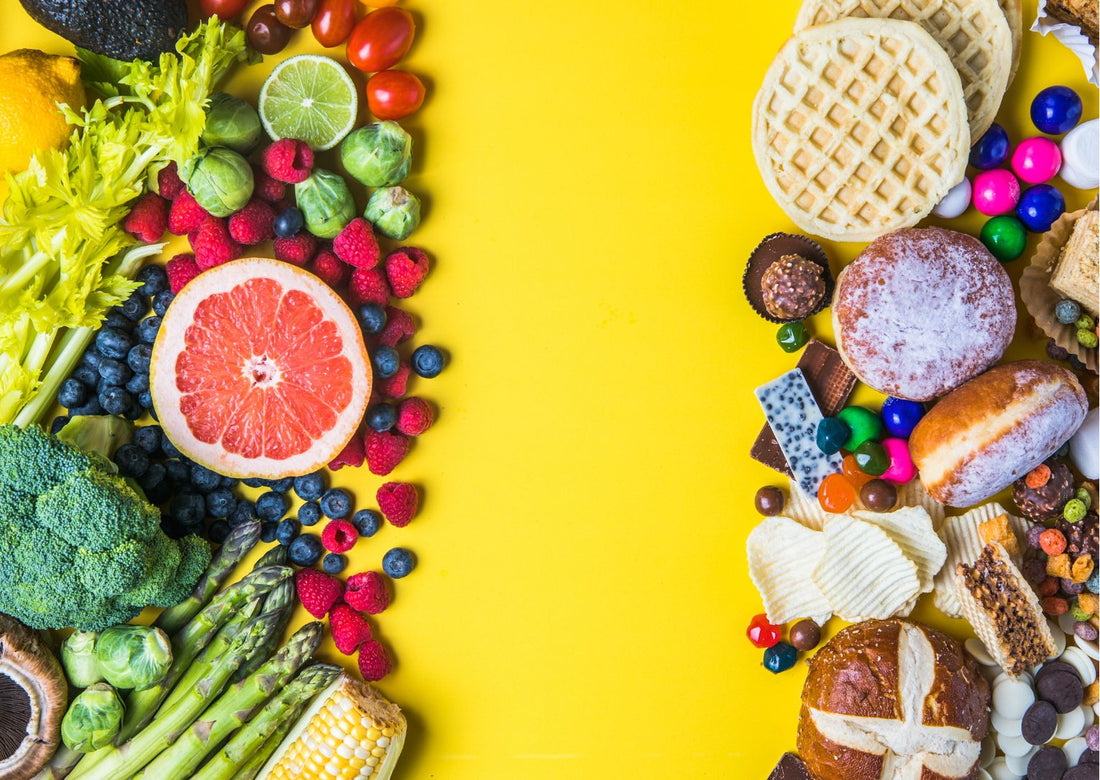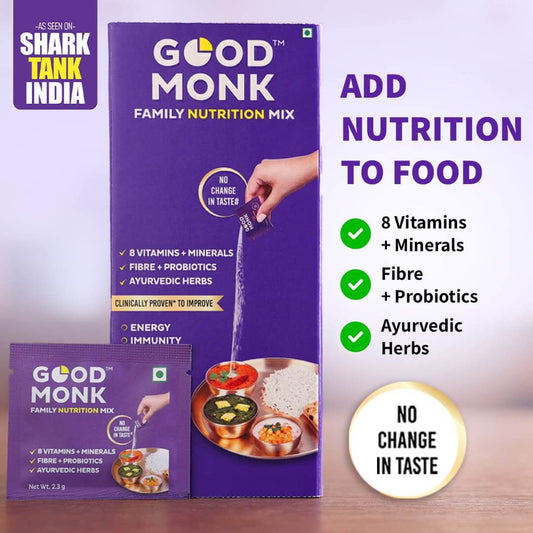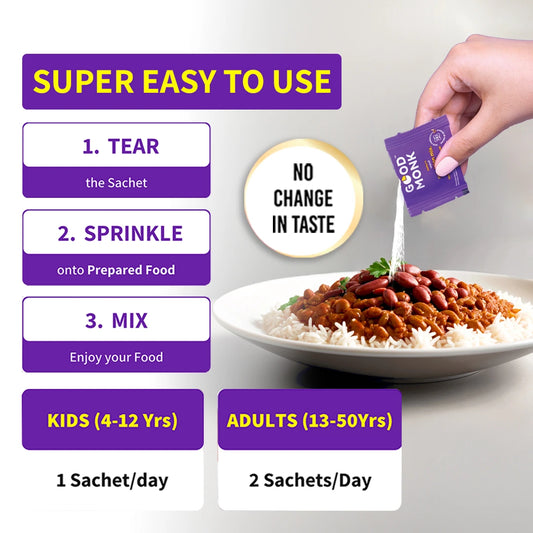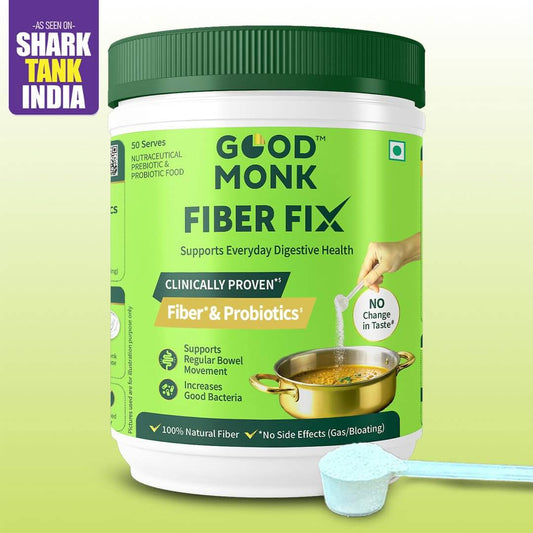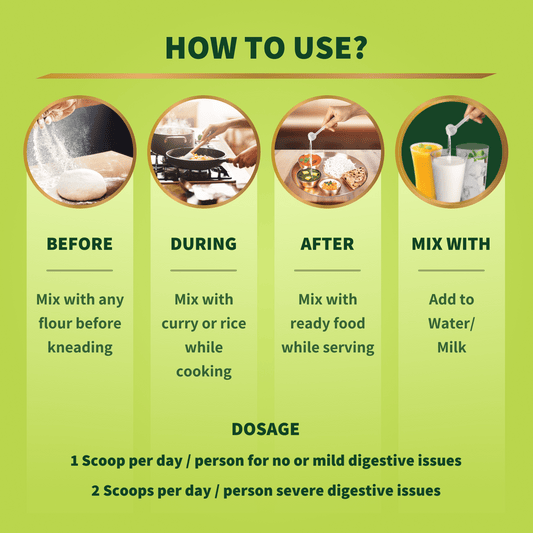What food we eat today creates our tomorrow. The growing popularity of fast food [1] has made the choice between healthy food and junk food more important than ever.
Junk food has become an indispensable part of our lives. Despite the growing craze over junk food, increasing awareness is also fueling the growth of concern about health impacts. There is no wonder why healthy food vs junk food has become a hot topic.
In this blog, we will understand the difference between junk food and healthy food and how it affects every part of our well-being. We also have a healthy food and unhealthy food chart for your easy reference and tips to come out of junk food addiction.
What Are Healthy Food And Junk Food?
The difference between healthy and unhealthy food lies primarily in their nutritional composition. Healthy food is not about strict limitations and depriving yourself of delicious foods. One could define healthy foods as those that contain vitamins, minerals, fibres, proteins, and healthy carbohydrates and fats. These nutrients are essential in addressing odd body metabolism and supporting normal body functioning.
On the other hand, fast food/junk food tastes delicious and is easy to prefer to highly processed items loaded with refined sugars, unhealthy fats, sodium, and artificial additives. These highly processed foods often lack essential nutrients, vitamins, and minerals.
Difference Between Healthy and Junk Food
The main purpose of differentiating between healthy and unhealthy food is to be able to make the correct choice for your body. Here are some tips that will help you discern between the two:
1. Nutritional Content:
Healthy Foods: Identify foods that contain some of the essential nutrients; these are vitamins, minerals, fibre and antioxidants. Fruits, vegetables, low-fat meats and poultry, fish, nuts, and whole-grain products are all healthy foods.
Unhealthy Foods: Avoid foods with many calories, fats, sugars, and sodium and little or no nutritional value. This often consists of foods that are refined, starchy foods, foods that are fried, and sweetened beverages.
Our blog on nutrition-rich foods to include in your diet will help you choose foods that provide essential vitamins and minerals for a healthier lifestyle.
2. Ingredient List:
Healthy Foods: Check the ingredient list for whole, recognisable ingredients. Aim for foods with minimal processing and additives.
Unhealthy foods: Junk foods have lists of artificial additives, preservatives, and flavourings and are often found in processed and packaged foods.
3. Nutrient Density:
Healthy Foods: Select foods in such a way that they are rich in nutrients since they pack many nutrients per calorie. Healthy foods like leafy green vegetables, berries, fish, and legumes are worth mentioning for their nutrient density.
Unhealthy Foods: Avoid highly processed junk foods that are calorie-dense and nutrient-poor, such as sugary treats, fried snacks, and processed meats.
To make the most of every bite you take, read our blog on understanding nutrient density.
4. Processing Level:
Healthy Foods: Opt for foods that are minimally processed or close to their natural state. Examples include fresh produce, whole grains, and lean proteins.
Unhealthy Foods: Avoid fast foods that go through a lot of processing since this removes most of the nutrients and dietary fibre from food. These unhealthy foods include products such as cereals, sweet babies, white bread, and chips, among others.
5. Added Sugars:
Healthy Foods: Limit foods and beverages with added sugars and opt for natural sources of sweetness, such as fruits and small amounts of honey or maple syrup.
Unhealthy Foods: Avoid foods with added sugars, including cakes and sweets, chocolate, biscuits, drinks including pop, fruit juice, sports drinks, and iced tea. Intake of excessive sugar is known to increase obesity levels, increase tendencies for diabetes, and cause other health complications.
Learn more about the impact of sugars on your health in our blog, understanding added sugar vs. natural sweeteners.
6. Portion Size and Moderation:
Healthy foods: Enjoy a balanced diet that includes a variety of nutrient-dense foods in appropriate portion sizes.
Unhealthy Foods: Reduce intake of foods rich in calories, sugars, and unhealthy fats. If you still have cravings for junk food and cannot control them, make sure that they are taken in moderation.
7. Effect on Overall Health:
Healthy Foods: Consuming a balanced diet rich in healthy foods supports overall health and reduces the risk of chronic diseases.
Unhealthy Foods: Regular consumption of unhealthy foods can lead to weight gain, high cholesterol, high blood pressure, and increased risk of chronic diseases such as diabetes and heart disease.
Healthy Food vs Junk Food Chart: A Side-by-Side Comparison
To make the difference between junk food and healthy food clear, here is a healthy food vs junk food chart.
|
Factor |
Healthy Food |
Junk Food |
|
Nutritional content |
Rich in vitamins, minerals, fiber and healthy fats |
High in calories, sugars, unhealthy fats and sodium. Low or no nutrients |
|
Processing |
Minimally processed. |
Highly processed with additives and preservatives |
|
Calorie density |
Low to moderate calorie density.nutrient dense |
High calorie density, low nutrients |
|
Ingredients |
Whole and natural ingredients |
Refined and synthetic ingredients with no nutritional value |
|
Sugar content |
Low in added sugar, natural sweetness |
High in added sugars |
|
Health benefits |
Weight management, heart health, immunity, digestion and more |
Weight gain, high cholesterol, diabetes, heart diseases etc |
|
Fats |
Healthy fats like omega 3s, monosaturated fats |
Unhealthy fats like trans fats and saturated fats |
|
Fiber content |
High in fiber |
Low in fiber |
|
Mental health[2] |
Supports mood stability and energy |
Negatively affects mood. Causes brain fog and increases anxiety |
What are the Benefits of Eating Healthy Foods?
There are multiple benefits of eating healthy food. Consuming foods rich in nutrients helps your body function smoothly. Being in good health is the real wealth you must invest in. Healthy eating has a multitude of benefits that last a lifetime. It has a positive impact on one’s physical and mental well-being. Here’s a list of the benefits of consuming healthy foods:
Helps Lose Weight
Helps Manage Diabetes
Improves Heart Health
Decreases Cancer Risks
Increases Immunity
Boosts Brain Health
Improves Digestion
Delays Ageing
Better Mood and Emotions
Improves Skin Health
Better Sleep
Learn what healthy foods to eat by reading our blog on vitamin-rich foods.
How to Enhance the Nutritional Value of Healthy Food?
If you have decided to be more healthy and junk food is going to go out of your diet, the next step is about nutrition. Adding nutrition to your food is easy with Good Monk, as our products have no fat, no added sugar, salt, or preservatives. Our range includes:
1. Nutrition Mix:
This is a health mix powder that can be added to the daily food with no difference in taste or smell. It helps boost immunity, improve digestion, make the bones healthy, and aid in mental development. Types of nutrition mixes are:
Healthy 50+ Nutrition Mix for Seniors
2. Instant fruit mixes:
These instant fruit mixes are added to the water and are easy to take. They are full of vitamins and minerals, have no added preservatives or artificial flavours, and are caffeine-free. They are a good source of hydration and keep energy levels high. Some of the instant fruit mixes are:
3. Milk Mix for Kids
Kids get addicted to junk food pretty fast. In fact, most of the junk food and unhealthy, sugar-loaded foods target kids as their primary customers. Good Monk’s superhero milk mix for kids offers 27 vital nutrients that are essential for kids. It also improves energy, immunity, brain, eye & gut health. The superhero milk mix comes in 3 different flavours.
4. Dietary fiber supplements
Adding a dietary fiber supplement to your diet supports healthy digestion, regulates blood sugar , ease bowel movements and helps in weight management. Good Monk’s fiber supplements can be easily added to daily food in a convenient way.
What are the disadvantages of eating junk food?
There is no such thing as healthy junk food. Daily intake of junk food is dangerous to your health in many ways, both to your body and your mind. The following are some drawbacks of eating junk food [3],[4]:
Nutritional Deficiency
Weight Gain and Obesity
Heart Diseases
Kidney and Liver damage
Cancer
Skin issues
Type II Diabetes
Poor Digestion
Negative Impact on Mental Health
Poor Dental Health
Addiction and Cravings
Healthy and Unhealthy Food Chart
Despite these temptations made by junk foods, it is always recommended that one take as many healthy foods as possible. Below is a list of healthy and unhealthy food chart.
|
Healthy Foods |
Junk/Unhealthy Foods |
|
Fruits and vegetables |
Sugary snacks |
|
Lean proteins (chicken, fish) |
Fried foods |
|
Whole grains (quinoa, brown rice) |
Processed meats (sausages, hot dogs) |
|
Nuts and seeds |
Sugary beverages |
|
Legumes (beans, lentils) |
Chips and other salty snacks |
|
Low-fat dairy products |
Pastries and desserts |
|
Healthy fats (avocado, olive oil) |
Fast food (burgers, fries) |
|
Water and herbal teas |
Sugary cereals |
This healthy and junk food chart provides a basic overview of what we should eat and what we should avoid for our well-being.
Also check out our blog on top macronutrients rich foods to include in your diet.
7 Tips to Eat Less Junk Food
-
Plan your meals: Organise your meals in advance to avoid impulsive junk food choices.
-
Snack wisely: Instead of unhealthy snacks, choose fruits, nuts, or even yoghurt to help avoid the feeling of hunger.
-
Stay hydrated: Drink water throughout the day to reduce the desire for junk food.
-
Shop smart: Avoid purchasing junk food and stock your kitchen with healthy options.
-
Portion sizing: When you still want to have junk food, keep portion sizes small to prevent overeating.
-
Create healthy eating habits: Make healthy eating a part of daily routine so that it becomes a habit.
-
Keep healthy foods visible: Place healthy snacks visible and within reach so that you are likely to choose them over junk food.
Conclusion
Well, in the junk food- healthy food debate, we need to prioritise our health first and make our choices clear. Check out Good Monk for health mix powders and other nutritional products to help you transition from junk food to healthy food.
Feed yourself and your family with the right choices!
FAQs on Healthy and Junk Food
1. Which is better, junk food or healthy food?
Healthy food is always a better choice as it gives essential nutrients that support overall health and well being. Junk food has empty calories and harmful fats that can cause health issues.
2. What is the difference between healthy and unhealthy foods?
Healthy foods are rich in essential nutrients like vitamins, minerals and fiber, while unhealthy foods have high amounts of unhealthy fats, added sugars and are low in nutrients.
3. How can you turn junk food into healthy food?
You can turn junk food into healthier food by choosing healthier cooking methods like baking and grilling instead of frying. You can also replace refined grains with whole grains,limit sugars and control portion sizes
4. Why are junk foods bad?
Junk foods are high in calories, fat, sugar, salt, and processed carbohydrates but low in nutrients such as vitamins, minerals, and fibres. Eating junk food regularly can put you at risk of obesity and other chronic diseases such as diabetes, heart disease, and cancer.
5. What junk food to avoid?
Eating junk food is of no good use. They are addictive and enhance your cravings. Some examples include fizzy beverages, fried potato products like fries or chicken, tinned products like biscuits or chips, sweets like cakes, cookies, or ice cream, and junk foods like pizza and burgers.
6. Can junk food fit into a healthy diet?
Of course, fast food candy and soda are not bad in moderation, but they should not be your primary source of nutrition. Thus, adhering to positive healthy food and negativity to the junk food chart can help maintain the balance of nutritional supply, mostly through eating healthier foods.
7. How does junk food affect mental health?
Eating junk food has been associated with health problems such as anxiety and depression. Unhealthy foods contain no nutrients, while healthy foods are helpful for brain and emotional stability.
References:
[1] https://www.grandviewresearch.com/horizon/outlook/fast-food-market/india
[2] https://www.health.harvard.edu/mind-and-mood/eating-ultra-processed-foods-tied-to-cognitive-decline
[3]https://www.health.harvard.edu/heart-health/why-junk-food-diets-may-raise-heart-disease-risk
[4] https://www.health.harvard.edu/staying-healthy/eating-junk-food-may-affect-deep-sleep
About the Author
Written by the team at Good Monk—a clean and honest nutrition brand supported by doctors and food scientists. Every product is backed by clinical studies and made to help families eat better, feel better, and live healthier every day.
